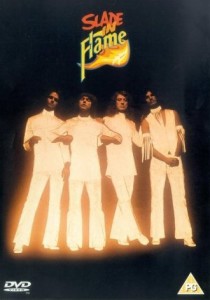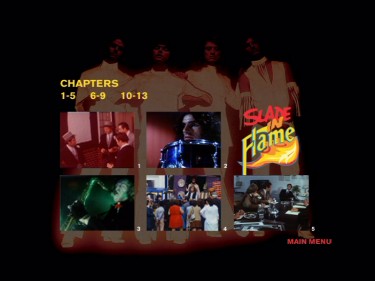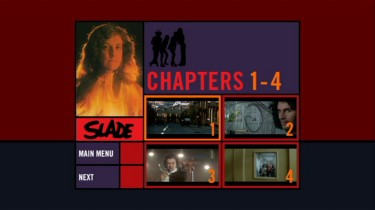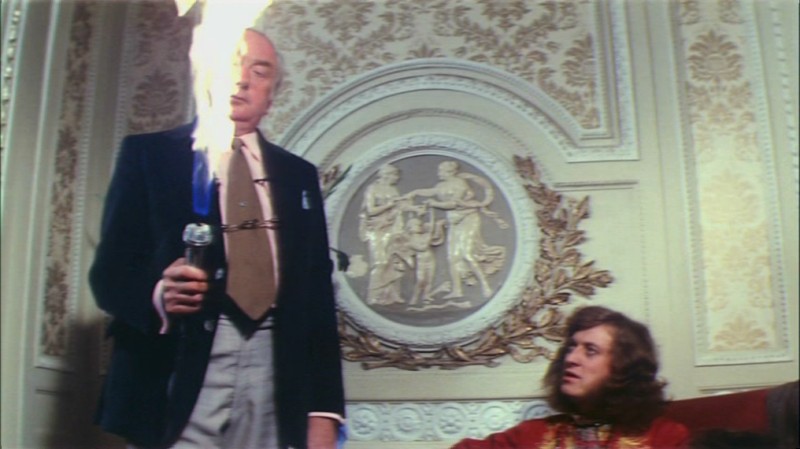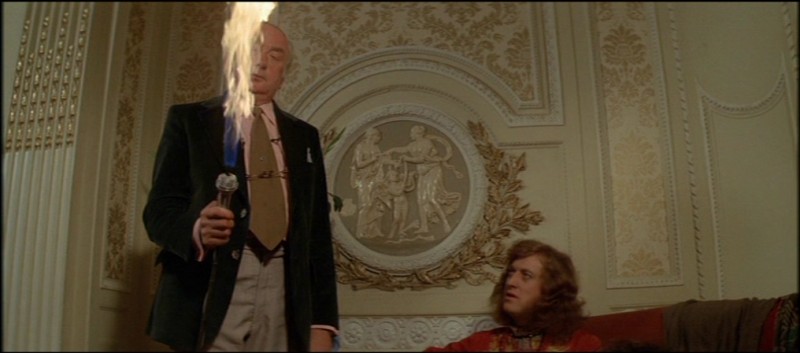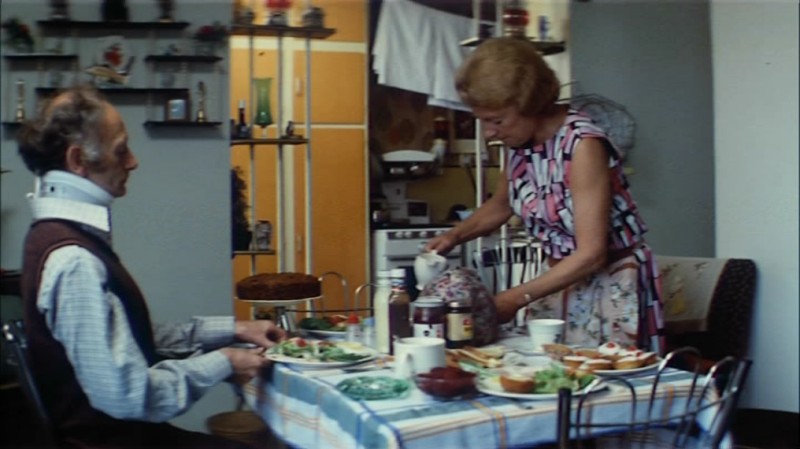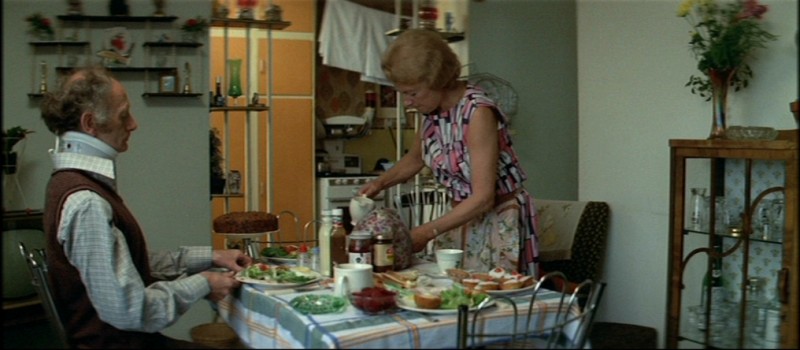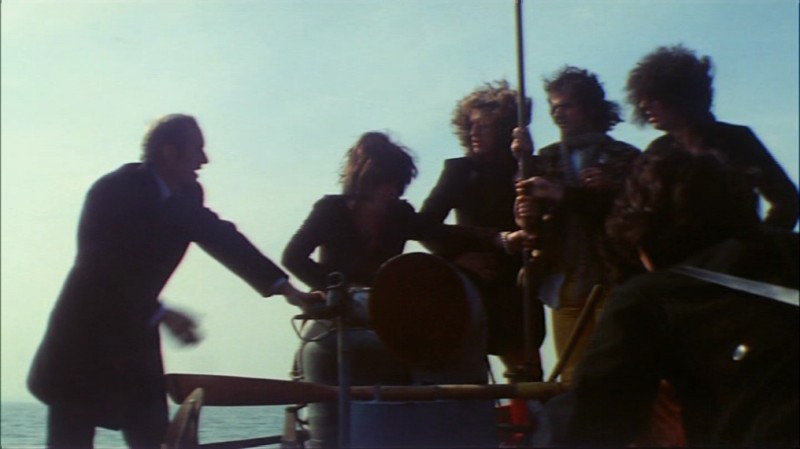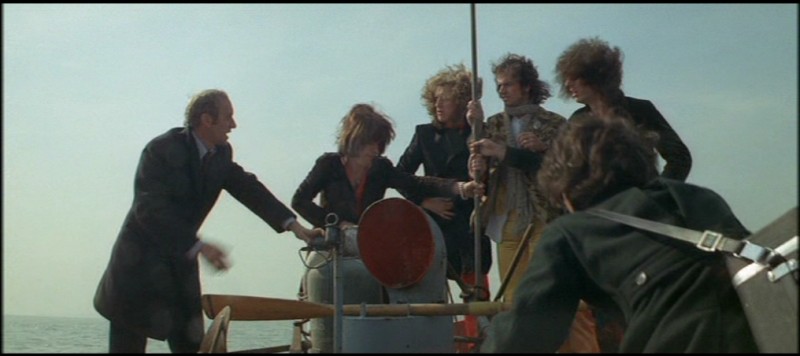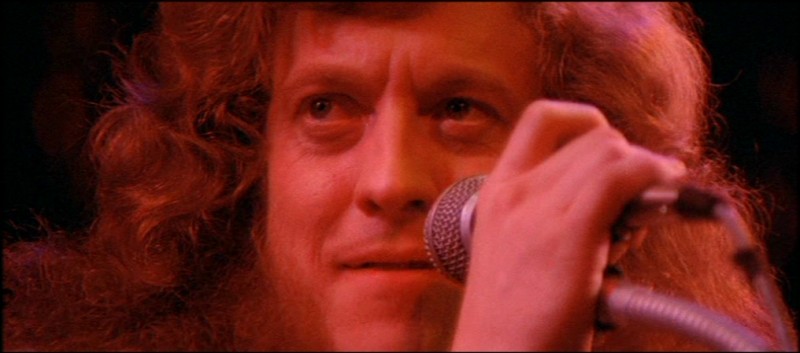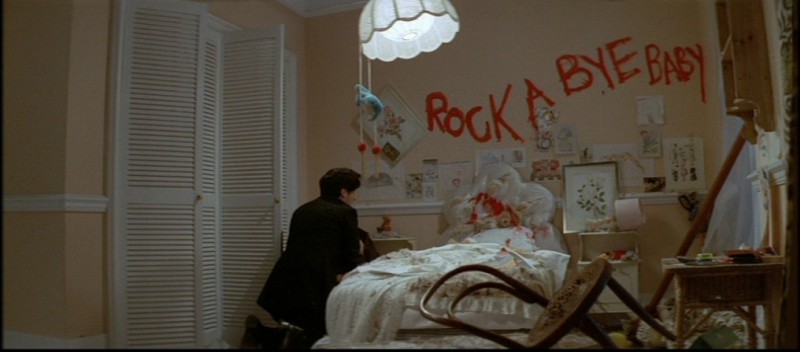![]()
![]()

![]()
![]()

(aka "Slade in Flame" )
directed by Richard Loncraine
UK 1975
The rock’n’roll movie Flame first hit the cinemas in 1975 and although more then 30 years have passed, it still holds up. The plot is intriguing, the cast well chosen and the music great.
The movie centres itself around the Wolverhampton-based rock group
Slade, who in the early 1970’s was the best selling British
act since the Beatles. In the film they don’t play themselves
though, but a working-class band called Flame.
The story takes place in the second half of the 1960’s and is about
the rise and fall of Flame as they get caught in a bitter
power struggle between their menacing two-bit agent and a slick
businessman. The consequences are grave, involving trouble with
wives and girlfriends, the firing (and molesting) of band- and
crew-members and last but not least the ruin of the band members’
friendships.
Flame is bleak, serious and gritty in its description of a greedy
music industry that is able to both make and break a band. It
exposes the downsides of the business and shows how the band is
transformed from hardworking musicians to a moneymaking product,
which everybody wants to milk.
The story is convincing, mainly because it is based on real events.
Before filming Slade took director Richard Loncraine and
screenwriter Andrew Birkin with them on tour in America and here
they told them stories about the music business. This way every
scene in the movie is based on true events, which had happened
either to Slade themselves or to other musicians.
Also the cast makes the story ring true. Especially Alan Lake
(husband of Diana Dors) as the former singer Jack Daniels and Johnny
Shannon (known from “Performance”)
as the menacing agent Ron Harding are convincing, but also Slade
themselves stand out. The four of them had never acted before but
they all do it with inspired naturalness.
Although Flame was not about Slade, their characters were based on
their real personalities. This made acting easy, even for drummer
Don Powell who had lost his short time memory in a car accident the
year before and has suffered from amnesia ever since. In the movie
his character Charlie (like in Charlie Watts) has the quick wit, the
brilliant one liners and - before turning pro - a day job in a steel
factory just like Powell himself. Bassist Jim Lea and his
Flame-alter ego Paul (like in Paul McCartney) are both family men,
serious, musically gifted and carries their basses in a plastic bag.
Guitarist Dave Hill and his character Barry (derived from J.M.
Barrie, the author of “Peter Pan”) are both ladies men with an
interest in fashion. And finally there’s the Flame-singer Stoker
(like in Bram Stoker, author of “Dracula”), who’s told not to nod
off, thereby hinting to Slade-singer Noddy Holder, who plays the
part. Both are talented showmen, who take to fame like ducks to
water. Holder and Lea act out most of the serious scenes, whereas
Hill and Powell provide the movie with some comic relief.
Worth noting are also the then up and coming Tom Conti in the role
as ruthless businessman Robert Seymour and Kenneth Colley as his
sidekick Tony. People will know Colley as Admiral Piett from the
Star Wars Episodes V and VI.
Flame has a problem, though, as director Loncraine has not succeeded
in creating an illusion of time passing. He – like screenwriter
Birkin – were novices in filmmaking, so although the plot expands
over 4 years, starting in 1966, you get the feeling that it all
happens within a couple of months, and that reduces credibility.
Only the changes in hair- and clothes-styles indicate the time span.
Loncraine later went on to Hollywood where he directed “Firewall”,
starring Harrison Ford.
Also screenwriter Birkin went on to fame, writing screenplays for “Perfume”
and “The
Name Of The Rose”, the script for “Joan Of Arc” and
cameoing in the latter two. Furthermore he is the official
biographer of Peter Pan’s “father” Sir J.M. Barrie, and Birkin even
sneaked the mention of Peter Pan into Powell’s canal-scene in Flame.
The movie spawned the book “Flame” by John Pidgeon, which was
published prior to the film. Some of the band members have later
vented that they would rather have filmed the book than the script,
as the book is superior in many ways, especially when it comes to
portraying characters. Here the Slade members’ mutual relationships
as well as their real personalities really burn through the Flame
characters of Charlie, Paul, Barry and Stoker and you get a better
understanding of why they react to their situation in the different
ways that they do. A lot of that had to be skipped in the movie,
probably because all of the violence and sex had to be cut out in
order to get a PG rating so that Slade’s fans – mostly teenagers –
were allowed to see the it. Maybe just as well as the audience of
the time couldn’t separate the band Slade from Flame, anyway,
and didn’t realise that they played characters. After the release of
the movie Slade always had to assure fans that in real life they
actually loved each other. At least they stayed together in the
original line-up for 25 years!
As a music film Flame functions very well. It contains 10
examples of Holder/Lea’s fantastic song writing partnership, which
shows why this team used to be compared to Lennon/McCartney. For the
first time ever Jim Lea made use of a full brass and woodwind
section when composing, in order to give the music a sixties-movie
feel. The film contains the super-hit “Far Far Away”, but it is the
haunting opening song “How Does It Feel?” that stands out in the
movie. Lea had composed the tune back in 1969 and by many this is
regarded the finest Slade song ever. Also “Them Kinda Monkeys Can’t
Swing” draws attention in the movie with Holder’s ambiguous lyrics
and a smash club performance.
The movie runs 86 minutes and is produced by Gavrik Losey. It was
shot on a low budget in London, Nottingham and Sheffield in just six
weeks.
Don Powell and I had a talk about the film recently. You can read
the interview
HERE.
Lise Lyng Falkenberg
www.liselyngfalkenberg.com
Posters
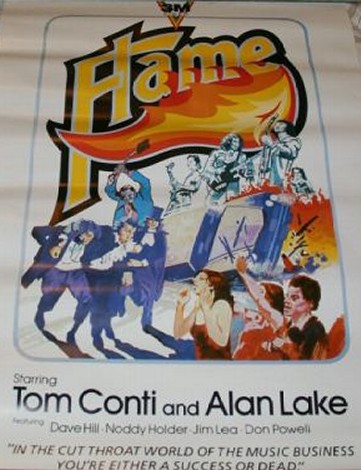 |
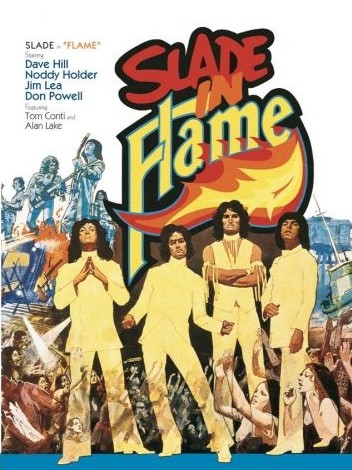 |
Theatrical Release: January 1975 - UK
Reviews More Reviews DVD Reviews
DVD Comparison:
Union Square Music - Region 0 - PAL vs. Union Square Music (CE) - Region 0 - PAL
Big thanks to Ole Kofoed for all the Screen Caps!
(Union Square Music - Region 0 - PAL - LEFT vs. Union Square Music (CE) - Region 0 - PAL - RIGHT)
| DVD Box Covers |
|
|
| Distribution |
Union Square Music Region 0 - PAL |
Union Square Music Region 0 - PAL |
| Runtime | 1:26:31 | 1:26:32 |
| Video |
1.78:1 Aspect Ratio
16X9 enhanced |
2.30:1 Original Aspect Ratio
16X9 enhanced |
|
NOTE: The Vertical axis represents the bits transferred per second. The Horizontal is the time in minutes. |
||
|
Bitrate:
Union Square Music
|
|
|
|
Bitrate:
Union Square Music (CE)
|
|
|
| Audio | Dolby Digital 2.0 mono |
PCM 2.0 mono |
| Subtitles | None. | None. |
| Features |
Release Information: Studio: Union Square Music Aspect Ratio:
Edition Details: Chapters 13 |
Release Information: Studio: Union Square Music Aspect Ratio:
Edition Details:
DVD Release Date: 2 April
2007 Chapters 14 |
| Comments: |
It is a bit problematic that Union Square
Film has chosen to release the film as “Slade in Flame”, using the title
and cover of the soundtrack album. It stirs a bit of confusion, as the
original name of the film was simply “Flame”.
Extras: |
DVD Menus
(Union Square Music - Region 0 -
PAL - LEFT vs. Union Square Music (CE) - Region 0 - PAL -
RIGHT)
|
|
|
|
|
|
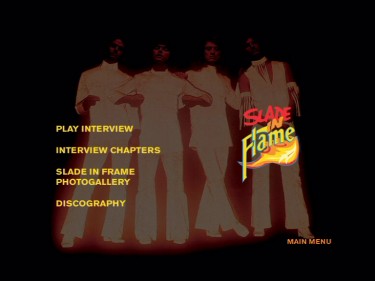 |
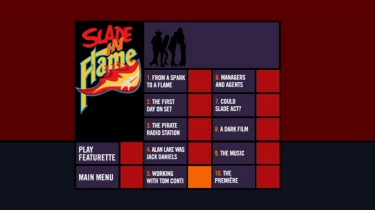 |
 |
 |
Screen Captures
(Union Square Music - Region 0 - PAL - TOP vs. Union Square Music (CE) - Region 0 - PAL - BOTTOM)
|
|
|
|
(Union Square Music - Region 0 - PAL - TOP vs. Union Square Music (CE) - Region 0 - PAL - BOTTOM)
|
|
|
|
(Union Square Music - Region 0 - PAL - TOP vs. Union Square Music (CE) - Region 0 - PAL - BOTTOM)
|
|
|
|
(Union Square Music - Region 0 - PAL - TOP vs. Union Square Music (CE) - Region 0 - PAL - BOTTOM)
|
|
|
|
(Union Square Music - Region 0 - PAL - TOP vs. Union Square Music (CE) - Region 0 - PAL - BOTTOM)
|
|
|
|
Report Card:
|
Image: |
CE |
|
Sound: |
-- |
| Extras: | CE |
| Menu: | CE |
![]()
![]()
![]()
![]()
